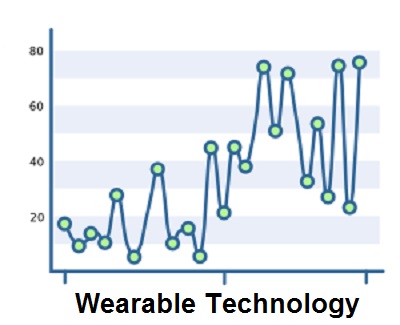A new report has shown that the market for wearables isn’t anywhere near leveling off in its expansion.
A new report relased by IDTechEx Research has shown that the marketplace for wearable technology is going to continue to grow, and that it won’t be doing so at a slow pace.
This has been particularly true when it comes to applications in industry as well as in the military.
This year, it is estimated that the wearables global market value is $20.2 billion in the IDTechEx Research report that was recently issued by the firm and that was entitled “Wearable Technology 2015-2015: Technologies, Markets, Forecasts.” It pointed out that almost 75 percent of the market’s revenue is expected to be generated from categories that have had the chance to mature a little more than others, such as fitness trackers, smartwatches, and earphones. However, it also underscored the fact that it will be wearables in military, industrial and commercial markets that will see the greatest growth and that will represent the largest amount of revenue.
The report specifically pointed out that it will be in these industries where wearable technology will be allowed to shine.
 As wearables are incorporated into a larger number of sectors and settings, the report stated that it will lead to a notable growth in the existing systems of this tech. That said, it pointed specifically to healthcare applications as the largest market for these mobile devices. “Many of the companies looking to commercialize new wearable technology are searching for partners in the healthcare and medical industries,” stated the report.
As wearables are incorporated into a larger number of sectors and settings, the report stated that it will lead to a notable growth in the existing systems of this tech. That said, it pointed specifically to healthcare applications as the largest market for these mobile devices. “Many of the companies looking to commercialize new wearable technology are searching for partners in the healthcare and medical industries,” stated the report.
Another market that was pointed out as one that should be seeing growth is that of infotainment, which should include products such as Oculus VR headsets, Google Glass and other types of smartglasses and augmented reality glasses.
The wearable camera market is another space that the IDTechEx said was up and coming. The release of this report comes on the heels of an announcement made in August by the Pentagon, which stated that a high-tech company and researcher consortium would be partnering to come up with wearable technology that would be appropriate for military applications.
There are some considerable advantages to wearables and they are becoming increasingly obvious.
With all the different DIY monitors and devices that patients have to use at home – which now include wearable technology in many different forms – the shape of the relationship between doctors and patients is starting to change, as is the care available from doctors and the care patients can provide themselves.
Blood pressure and glucose monitors, fitness bands, and other devices make tracking easier.
Wearable technology has pushed this trend forward very quickly, as wristbands and smartwatches offer sensors that can perform functions such as heartbeat and blood pressure tracking, sleep tracking, activity tracking and a range of other capabilities. Not only is it giving patients the ability to better understand the functions of their body systems, over time, but according to Yale University medical professor, Stephen Huot, doctors are already starting to see the benefits of the use of these wearables.
This helps to explain why so many people are using wearable technology and why this trend is growing.
 In 2012, Pew Research Center conducted a nationwide survey that determined that even by that time, 69 percent of adults were monitoring at least one indicator of health and wellness. These included diet, weight or exercise. Among them, 21 percent said that they were using a form of technology to be able to track that particular indicator. That said, Pew now projects that as weareables become more readily available, it will skyrocket in popularity, to the point that people will be commonly using wearable or even embedded devices by 2025.
In 2012, Pew Research Center conducted a nationwide survey that determined that even by that time, 69 percent of adults were monitoring at least one indicator of health and wellness. These included diet, weight or exercise. Among them, 21 percent said that they were using a form of technology to be able to track that particular indicator. That said, Pew now projects that as weareables become more readily available, it will skyrocket in popularity, to the point that people will be commonly using wearable or even embedded devices by 2025.
Pew also explained in the report on its research that among the survey participants, 46 percent felt that their behaviors in tracking their health indicator(s) had altered their overall approach to a healthful lifestyle or toward someone else for whom they were providing care. Furthermore 40 percent of the survey participants said that the data they had collected by tracking had driven them to pose new and different questions to their doctors, or had even encouraged them to obtain a second opinion.
For this reason, doctors are increasingly prescribing the use of wearable technology, particularly for monitoring certain chronic conditions, such as patients with diabetes.
 As wearables are incorporated into a larger number of sectors and settings, the report stated that it will lead to a notable growth in the existing systems of this tech. That said, it pointed specifically to healthcare applications as the largest market for these mobile devices. “Many of the companies looking to commercialize new wearable technology are searching for partners in the healthcare and medical industries,” stated the report.
As wearables are incorporated into a larger number of sectors and settings, the report stated that it will lead to a notable growth in the existing systems of this tech. That said, it pointed specifically to healthcare applications as the largest market for these mobile devices. “Many of the companies looking to commercialize new wearable technology are searching for partners in the healthcare and medical industries,” stated the report.
 In 2012, Pew Research Center conducted a nationwide survey that determined that even by that time, 69 percent of adults were monitoring at least one indicator of health and wellness. These included diet, weight or exercise. Among them, 21 percent said that they were using a form of
In 2012, Pew Research Center conducted a nationwide survey that determined that even by that time, 69 percent of adults were monitoring at least one indicator of health and wellness. These included diet, weight or exercise. Among them, 21 percent said that they were using a form of 